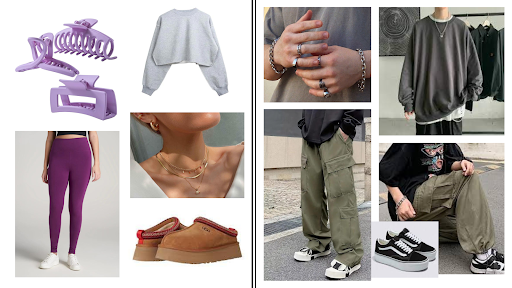Perceptions affect the world with bias and opinions — built into the human species as a survival method to assess danger in the wild. But humans haven’t needed to survive in the wild for several hundred years and the need for perception creates our biases. Especially in High School, the way a student represents themselves can change one’s entire world.
High schoolers tend to make quick assumptions about other students based on how they walk, talk, dress, and identify without ever talking to them. So what is the impact perceptions have on students? What does it mean to dress in a certain way? How would teenagers at Leesville treat me if I acted differently or dressed differently?
I committed to trying on the challenge and seeing how high school students would treat me if I acted differently in class and the hallways.
Disclaimer:
I’m aware that some believe that clothing doesn’t have gender, and I can agree and disagree. I believe clothing has a gender, but that gender is always changing. One piece of clothing might be masculine one year and feminine the next — androgynous is also a gender of clothing the range of clothing identity is a scale.
Planned Parenthood writes. that, “Depending on who you ask, different types of clothing can seem feminine, masculine, gender neutral, or something else. The gendering of clothing, just like people, is a construct. No matter your society or culture, clothing is an important way for you to express yourself, feel like yourself, and feel good.”
I believe that…
- yes, gender and gendered clothing is a social construct
- Gendered clothing can change and falls on a spectrum, Example: Pants
- gendered clothing can be meaningless to some but to others it is useful and we should respect all opinions
- society still depends on their perception and bias; you can’t get rid of it, biased instincts have been around for thousands of years. It’s not something we can just ignore as it does have an effect even if we try to deny it doesn’t, because that’s human nature.
In this article, I will be referencing clothing and styles in how they are popularly perceived by the general society and the effect those perceptions will have on me.
The Start:
My interest in perception and bias all came about when a friend in my Newspaper class, told me I dressed so gay she didn’t know I liked guys as well as girls. I didn’t take offense to it because it caught me off guard, I just throw on outfits that are comfortable in the morning. I didn’t realize how others’ perceptions of me affected how they interacted or saw me as a person. And it made me ask myself, how did I want to be perceived? So I decided to do a little experiment.
First I wanted to try out different outfits and since I dressed “gay” I wanted to try to dress straight and see how others saw me.
Well since I wasn’t quite sure how straight students dressed I asked my two friends Hannah Lewis, junior, and Josie Frazier, junior, over text — “But how does one dress straight.”
My two friends suggested leggings with an oversized off-the-shoulder shirt. The kind where “You can see the strap of your bra,” texted Frazier. I was also suggested to wear fitted clothing if I didn’t go baggy.
As someone who loves jeans and pants, I haven’t worn leggings at school since seventh or eighth grade. Wearing tight clothing isn’t functional or comfortable, so I let myself decide to wear what I thought was best.
I decided to wear purple leggings with sneakers, a cropped gray sweatshirt to highlight the waist, and gold jewelry, complete with a purple matching hair claw.
The reactions were mixed — yes I looked more the part of a ‘typical straight teenage girl,’ but I felt like I wasn’t myself. It was fun to dress up as someone else but in the end, it wasn’t me.
I was treated differently too, as it seemed the more tight, cute, and feminine I dressed the more men would notice me. Normally, I help holding doors but surprisingly more guys held doors for me. But what was shocking was the attention I got from other women.
Two types of girls interacted with me. 1)Those who complimented me and told me I looked good. Or 2) The women who would look me up and down when I entered the room, who I could feel silently judging me. As always there were instances where I was treated the same, but as I presented more feminine and girly the more like a woman I was treated.
The Second:
Upon the realization that dressing feminine or masculine has a big effect on how others treat you, I decided to test out another theory through the students at Leesville. What if I carry myself differently? How would people treat me if I acted differently?
So I tried it out. First I decided to walk and talk feminine. Then I decided to walk and talk masculinely.
Feminine consisted of walking one foot in front of the other, using the hips to walk, trying to take up as little space as possible, and holding my hands in front of me and out of the way. Acting feminine means twirling my hair, smiling more, wearing makeup, and cute hairstyles. Making my shoulders narrower, and crossing my legs when I sit. This made me feel smaller; I took up less space. I felt minimized, that being a girl was all I was; I couldn’t sit the way I wanted less I looked too masculine.
Masculine consisted of walking side to side, steps as wide as my shoulder width. Making my shoulders as wide as possible, arms by my sides, in my pockets, and elbows flared out to take up as much room as possible. I would sit with my legs as far as they could reach and cross my legs only in a square shape with my ankle on my thigh. I would hold my ground when other guys tried to push past me. No makeup, hair down, or crudely in a ponytail. To stand as tall as 4 feet 11 inches would let me. It made me feel powerful and protected. Since I tend to be a more masculine sized person this was easier for me than being overly feminine might. But it also felt good to know that I could be a woman and take up space, that it wasn’t my duty to be feminine and sink into the background.


Leave a Reply